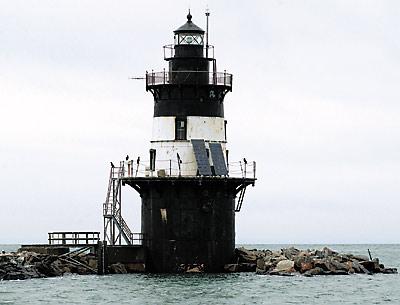Water Views, Foghorns Included

Attention fishermen, recluses seeking a hideaway, writers of novels, the recently divorced, or any combination thereof. The General Services Administration is auctioning off two lighthouses in our neck of the woods. Bids, starting at $10,000, are now being accepted for the lighthouse on Little Gull Island and for the Orient Point Light.
Your solitude will be interrupted only by an occasional visit by a member of the Coast Guard. The Department of Homeland Security will maintain the right to service the aids to navigation, but what the heck.
Notwithstanding the attraction the lights might hold for the average misanthrope, the fact that both look down upon some of the richest sportfishing grounds in world make either one a perfect redoubt for the serious angler. They even come with protected boat landings. And, there’s history.
The Orient Point light was built in 1899. It’s located in Plum Gut between Long Island Sound and Gardiner’s Bay about half a nautical mile offshore of Orient Point in the Town of Southold. The structure consists of a brick-lined cast iron-plated tower section able to repel most attempts to scale it.
The south-facing portion, a boat landing, consists of a steel frame with timber and rubber fenders constructed on a portion of manmade riprap built upon Oyster Pond Reef. The light stands 45 feet tall with six levels including two watch decks and three stories of living quarters. The G.S.A. notes that the Orient Point Light is located near a number of public marinas “with dining, retail, and recreationl options in nearby Greenport.”
Little Gull Island is about an acre in size. It lies less than a mile northeast of Great Gull Island. Both islands are midway between Plum and Fishers Island near the channel (full of striped bass and bluefish during the summer) known as the Race.
The first lighthouse was built on Little Gull in 1806. The light was extinguished by a group of Royal Marines led by Commodore Thomas Hardy during the War of 1812. Fifty-six years after the Brits attacked, the light was upgraded to 81 feet, and outfitted with a second order Fresnel lens. The light tower is constructed of granite and contains about 450 square feet of space.
On May 12, 1881, the Galatea bound from Providence, R.I., to New York ran aground on Little Gull in the fog.
Oh, that’s the only other minor problem. The foghorns on both islands are loud enough to raise the dead. Okay, so wear earplugs. The combination of fog and earplugs can’t help but focus one’s meditations.
It must be mentioned that when the Galatea ran aground, her captain swore he did not hear the horn. However, interviews conducted after the mishap revealed that the horn was heard as far away as Mystic, Conn. A man named French Ensor Chadwick (no kidding) was the naval officer who led the investigation and determined that the signal was working at the time of the grounding.
Chadwick’s report noted that the aberrations and eccentricities around Little Gull were significant.
The bidding began on June 1. So far, two people have bid on the Little Gull Light. The top bid stands at $60,000. Four are after the Orient Point Light, top bid, $25,000. The bidding remains open. Auction rules, as well as applications for registration can be found on the G.S.A.’s Web site, gsaauctions.gov.
